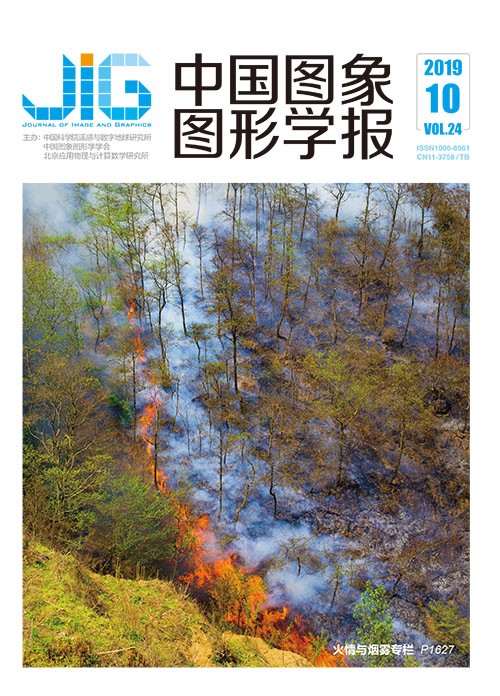
时间压缩轨迹特征识别的火灾烟雾检测
摘 要
目的 检测烟雾可以预警火灾。视频监控烟雾比传统的单点探测器监控范围更广、反应更灵敏,对环境和安装的要求也更低。但是目前的烟雾检测算法,无论是利用烟雾的色彩、纹理等静态特征和飘动、形状变化或者频域变化等动态特征的传统方法,还是采用卷积神经网络、循环神经网络等深度学习的方法,准确率和敏感性都不高。方法 本文着眼于烟雾的升腾特性,根据烟雾运动轨迹的右倾直线特性、连续流线型特性、低频特性、烟源固定特性和比例特性,采用切片的方式用卷积神经网络(CNN)抽取时间压缩轨迹的动态特征,用循环神经网络(RNN)抽取长程的时间关联关系,采用分块的方式提高空间分辨能力,能准确、迅速地识别烟雾轨迹并发出火灾预警。结果 对比CNN、C3D (3d convolutional networks)、traj+SVM (trajectory by support vector machine)、traj+RNNs (trajectory by recurrent neural network)和本文方法traj+CNN+RNNs (trajectory by convolutional neural networks and recurrent neural network)以验证效果。CNN和C3D先卷积抽取特征,后分类。traj+SVM采用SVM辨识视频时间压缩图像中的烟雾轨迹,traj+RNNs采用RNNs分辨烟雾轨迹,traj+CNN+RNNs结合CNN和RNNs识别轨迹。实验表明,与traj+SVM相比,traj+CNN+RNNs准确率提高了35.2%,真负率提高15.6%。但是深度学习的方法往往计算消耗很大,traj+CNN+RNNs占用内存2.31 GB,网络权重261 MB,前向分析时帧率49帧/s,而traj+SVM帧率为178帧/s。但与CNN、C3D相比,本文方法较轻较快。为了进一步验证方法的有效性,采用一般方法难以识别的数据进一步测试对比这5个方法。实验结果表明,基于轨迹的方法仍然取得较好的效果,traj+CNN+RNNs的准确率、真正率、真负率和帧率还能达到0.853、0.847、0.872和52帧/s,但是CNN、C3D的准确率下降到0.585、0.716。结论 从视频的时间压缩轨迹可以辨认出烟雾的轨迹,即便是早期的弱小烟雾也能准确识别,因此traj+CNN+RNNs辨识轨迹的方法有助于预警早期火灾。本文方法能够在较少的资源耗费下大幅度提高烟雾检测的准确性和敏感性。
关键词
Smoke detection by trajectories in condensed images for early fire warning
Luo Sheng1, Zhang Xiang1,2, Hu Jie1, Wang Muchou1, Zhang Xiaoqing1(1.School of Mechanical & Electrical Engineering, Wenzhou University, Wenzhou 325000, China;2.Wenzhou Mingcheng Construction Investment Group Co., Ltd., Wenzhou 325000, China) Abstract
Objective Smoke detection by surveillance cameras is reasonable to warn fire. This technology has many advantages compared with other traditional point detectors. Wide areas could be covered, rapid respondence could be available, and installation and maintenance requirements could be less. However, the current smoke detection algorithms are unsatisfying in terms of accuracy and sensitivity due to the varying colors, shapes, and textures of smoke. The traditional studies focus on designing handcrafted features that extract such static features as colors, shapes, and textures and dynamic ones, including shape deforming, drifting, and frequency shifting. This task is time consuming. Although the algorithm exhibits good characteristics, maintaining its robustness for all environments is difficult. The detection effectiveness often sharply descends when these methods are applied in different environments. The fashionable methods, such as convolution neural network (CNN), recurrent neural network (RNN), and other statistical methods, are based on deep learning. However, applying these methods is difficult because the surveillance platforms have limited resources. These networks are also unsatisfying in terms of accuracy and sensitivity. Method The proposed method utilizes trajectories in condensed images, which are summed in horizontal and vertical directions for all video pixels. Smoke trajectories in condensed images are always right-leaning, straightly linear, proportional, and streamline-like with low frequencies and fixed starting points. Accordingly, surveillance videos are summed into condensed images, sliced, and then fed into CNN to extract features to find the long-term relationship by RNN. Partitioning strategy is also adopted to improve sensitivity. Therefore, the method uses not only the trajectory shapes but also the short- and long-range relationships in the time domain to detect the existence of smoke in videos. Result Controlled experiments of CNN, C3D(3d convolutional networks), traj + SVM(support vector machine), traj + RNNs, and traj + CNN + RNNs are conducted. The CNN and C3D methods are typical deep learning networks that initially extract features and then make judgments. The traj + SVM method detects smoke trajectories by traditional SVM algorithm, the traj + RNNs method finds smoke trajectories by RNNs, and the traj + CNN + RNNs method recognizes smoke trajectories by combining CNN and RNNs, which is the proposed method. The accuracy of the traj + CNN + RNNs method is increased by 35.2% compared with that of traj + SVM, and the real negative rate is increased by 15.6%. However, the computing cost of the traj + CNN + RNNs method is relatively high. The frame rate, maximum memory consumption, and network weight are 49 frame/s, 2.31 GB, and 261 MB, respectively. By contrast, the frame rate of traj + SVM is 178 frame/s. The computing cost of deep learning networks is generally high. Nevertheless, the traj + CNN + RNNs method is the lightest and fastest among all deep learning networks. Some confusing data for many traditional methods are collected for the second experiment to further compare these methods. The methods based on trajectories, namely, traj + SVM, traj + RNNs, and traj + CNN + RNNs, remain at a good level, and the indexes of ACC(accaracy), TPR(trure positive rate), and TNR(true negative rate) and the sensitivity are 0.853, 0.847, 0.872, and 52/26(frame/s), respectively. However, the corresponding indexes of CNN and C3D considerably reduced. The accuracies of CNN and C3D are 0.585 and 0.716, respectively. Conclusion The proposed method helps improve the accuracy and sensitivity of smoke detection. The smoke trajectories can be identified from the condensed images, even from those of early smoke, which are helpful for early fire warning.
Keywords
|



 中国图象图形学报 │ 京ICP备05080539号-4 │ 本系统由
中国图象图形学报 │ 京ICP备05080539号-4 │ 本系统由